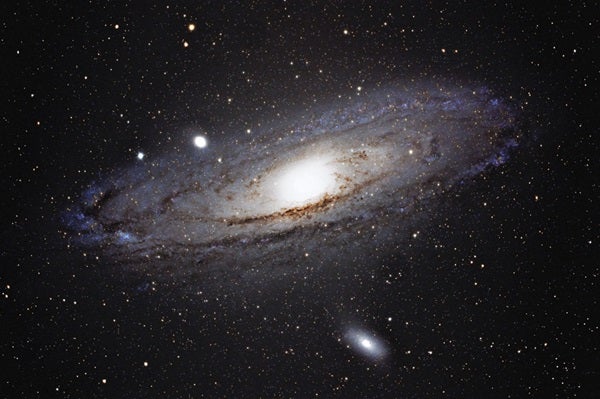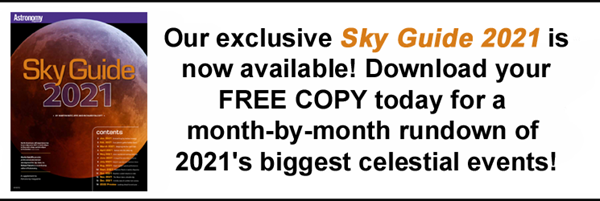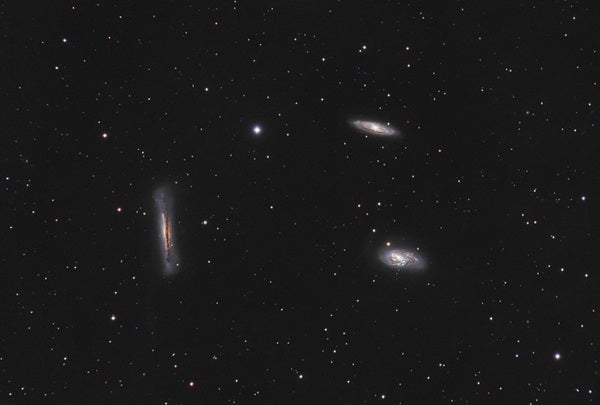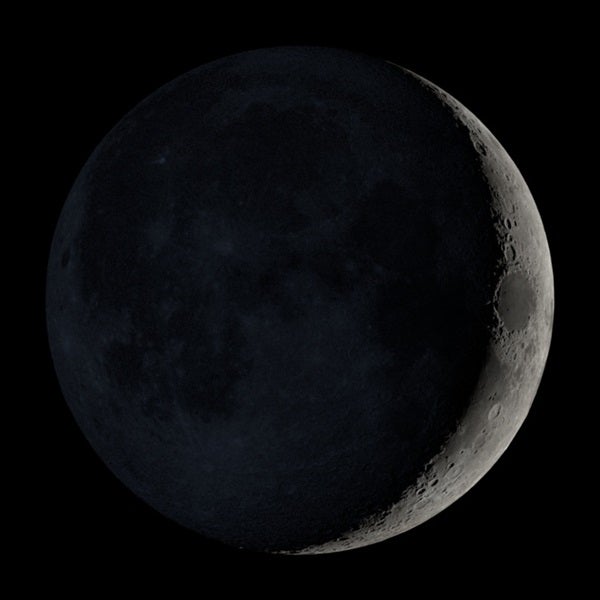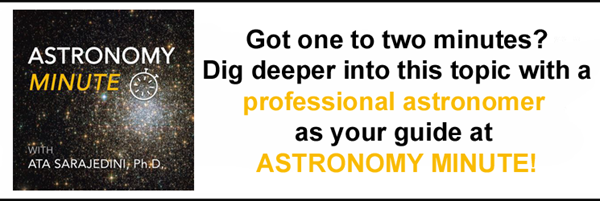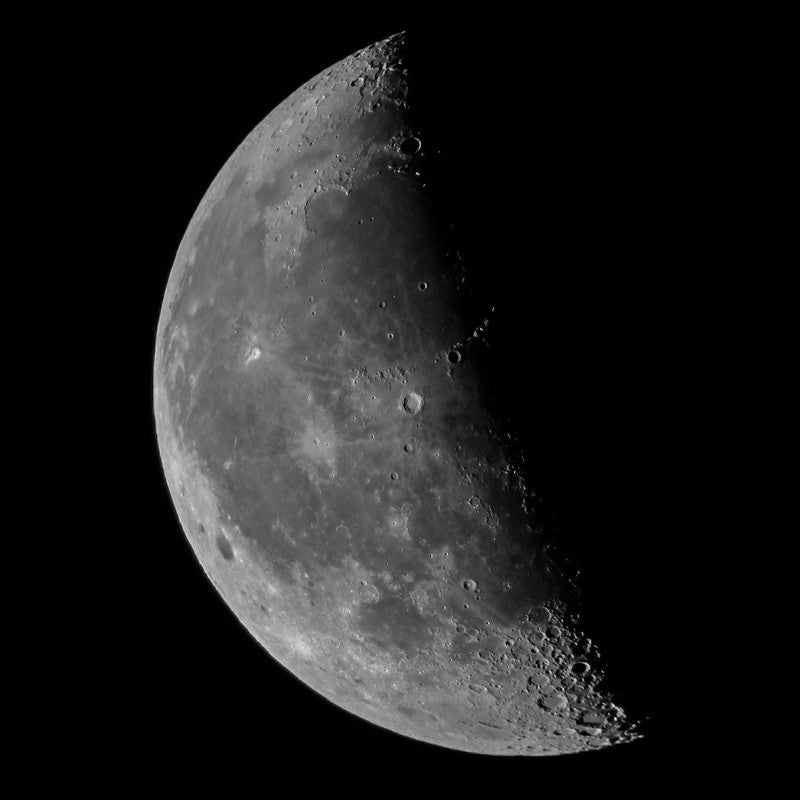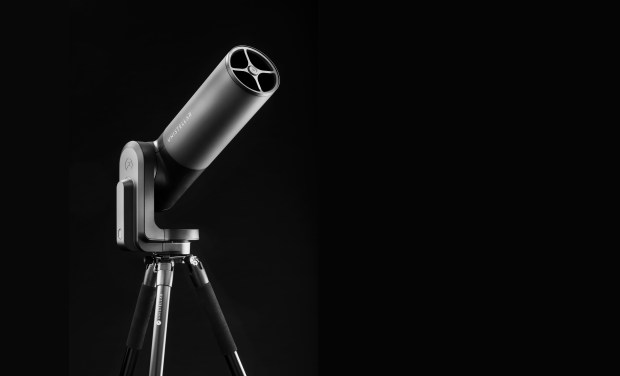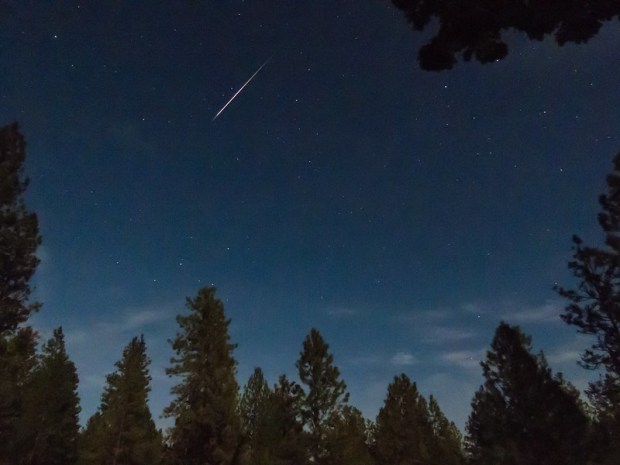Friday, March 12
It’s time to get your Messier marathon on! This weekend is the ideal time to run this year’s Messier marathon, during which observers challenge themselves to find every object in the famous comet hunter’s catalog in a single night. All you need is binoculars or a small scope, some dedication, and possibly some caffeine and snacks to keep you going all night long as you tick off each object on the list.
Some of the most popular and easy-to-spot Messier objects are the Orion Nebula (M42), the Pleiades (M45), the Beehive Cluster (M44), the Great Globular Cluster in Hercules (M13), and the Andromeda Galaxy (M31).
But maybe you don’t have time to run a full marathon. In that case, consider challenging yourself to find one of the one of the faintest objects on the list: M97, also known as the Owl Nebula. This magnitude 11 planetary nebula is located in Ursa Major, about 2.3° southeast of magnitude 2 Merak. The nebula requires a 3-inch telescope or larger to spot, and typically appears gray-green to the human eye. In larger scopes, you may notice two dark patches within the spherical remnant that are reminiscent of an owl’s eyes.
For more tips on how to run a Messier marathon, we’ve got you covered over here: It’s time for the 2021 Messier marathon!
Sunrise: 6:16 A.M.
Sunset: 6:04 P.M.
Moonrise: 6:19 A.M.
Moonset: 5:25 P.M.
Moon Phase: Waning crescent (1%)
*Times for sunrise, sunset, moonrise, and moonset are given in local time from 40° N 90° W. The Moon’s illumination is given at 12 P.M. local time from the same location.
Saturday, March 13
Today’s New Moon makes it perfect for not only observing the full catalog of faint Messier objects, but another faint feature of the night sky as well: the zodiacal light. Visible after sunset at this time of year, this cone-shaped glow is generated by sunlight scattering off dust left by comets and asteroids as they make their way through the inner solar system.
At least, that’s the historically accepted explanation — but new observations with the Juno probe currently circling Jupiter suggest that perhaps martian dust might be responsible for the zodiacal light.
Regardless of its source, for the best chance of spotting the zodiacal light, look west after twilight for a spear of light rising up through the constellations Aries and Taurus. The darker your sky and the higher your elevation, the more likely it is you’ll see it. The zodiacal light is a popular astrophotography target as well; a wide-angle lens on a camera capable of taking 15- to 30-second exposures should be all you need to get an amazing shot.
Sunrise: 6:14 A.M.
Sunset: 6:05 P.M.
Moonrise: 6:45 A.M.
Moonset: 6:26 P.M.
Moon Phase: New
Sunday, March 14
Daylight saving time begins this morning at 2 A.M. local time, meaning that instead of striking 2 A.M., your clock will skip right from 1:59 A.M. standard time to 3 A.M. DST.
Saturn now rises by 5:20 A.M. local time, with Jupiter following half an hour later. Mercury rises around 6:20 A.M. local time, giving you far less time to spot the speedy planet than earlier this month. It’s now a bright magnitude 0, but only 3° high by 6:40 A.M. The tiny world lies in Aquarius, just over the border from Capricornus, where you’ll find the gas giants higher in the sky. By this time, few stars remain visible in the growing twilight. Only the brightest still peek out, including Altair, Deneb, and Vega — the familiar Summer Triangle’s bright points.
Sunrise: 6:12 A.M.
Sunset: 6:06 P.M.
Moonrise: 7:09 A.M.
Moonset: 7:27 P.M.
Moon Phase: Waxing crescent (2%)
Monday, March 15
Asteroid 4 Vesta sits right between a pair of 6th-magnitude stars (HIP 54319 and HIP 54470) in Leo the Lion tonight. The magnitude 6 main-belt asteroid should be easy to find with binoculars, just 3.4° southwest of Zosma. Seeing the asteroid move in a single observing session is challenging, but you can use the two field stars to chart Vesta’s motion over the next few days to really see it slide against the background.
If you’re still in a Messier mood, Leo contains five of Messier’s objects, all galaxies: M65, M66, M95, M96, and M105. M66 is the brightest at magnitude 8.9, located about 2.8° southeast of Chertan and part of the famous Leo Triplet of galaxies, which also contains NGC 3628 and M65. The brightest two of the three, M65 and M66, are visible in nearly any binocular, although you’ll want large binoculars (70mm) or a small scope to bring the edge-on spiral NGC 3628 into view.
Sunrise: 7:11 A.M.
Sunset: 7:08 P.M.
Moonrise: 8:32 A.M.
Moonset: 9:27 P.M.
Moon Phase: Waxing crescent (5%)
Tuesday, March 16
The Moon passes 3° south of Uranus at 10 P.M. EDT. Our satellite, less than four days old and only 12 percent lit an hour after sunset, currently straddles the border between Cetus and Aries. Just visible along the lit lunar edge is Mare Crisium, the Sea of Crises. This dark, round feature is roughly 3.9 billion years old and spans about 460 miles (740 kilometers). On its western side are two small craters: Pierce to the south and Swift to the north. And north of the mare’s rim is the large crater Cleomedes, which stands out in stark relief now but will begin to disappear as the Moon grows closer to Full, losing contrast along the way.
Sunrise: 7:10 A.M.
Sunset: 7:08 P.M.
Moonrise: 8:55 A.M.
Moonset: 10:26 P.M.
Moon Phase: Waxing crescent (10%)
Wednesday, March 17
As Jupiter rises this morning, its innermost moon, Io, is transiting across the disk. By 6 A.M. CDT, Io stands close to the planet’s western limb, ready to slip off less than 10 minutes later. It’s a great view: all four Galilean moons are visible, with Io now sitting between Jupiter and Earth. Europa is to Jupiter’s west, while to the east are Callisto (closer in) and Ganymede. Callisto lies just 9″ from a field star, so don’t confuse the two.
Jupiter itself spans 34″ and shines at magnitude –2. The gas giant’s visibility will only continue to improve over the next several months as it heads for opposition later this year, so don’t worry if its proximity to the horizon makes it challenging to see right now. Better days are coming!
Sunrise: 7:08 A.M.
Sunset: 7:09 P.M.
Moonrise: 9:21 A.M.
Moonset: 11:26 P.M.
Moon Phase: Waxing crescent (17%)
Thursday, March 18
The Moon reaches apogee, the farthest point from Earth in its orbit, at 1:03 A.M. EDT. It will then stand 251,812 miles (405,252 km) from our planet.
Tonight, the Moon stands in Taurus; look west of this constellation to find Aries the Ram, whose brightest star is magnitude 2 Hamal. The star’s name, appropriately, means “the lamb” in Arabic. Nearly 10.5° south of Hamal is Uranus, which, at magnitude 5.9, is near the limit for naked-eye observing. If you’re in a particularly dark, clear location, you may be able to spot it. If not, binoculars will easily show its 3″-wide blue-gray disk.
Continue about 13.5° southeast of Uranus and you’ll find Menkar, the magnitude 2.5 alpha star of Cetus the Whale. Although Cetus’ star Mira (12.8° southwest of Menkar and now very close to the horizon) is a more well-known variable star, Menkar is also variable, changing in brightness by about six percent with no known regular period.
Sunrise: 7:06 A.M.
Sunset: 7:11 P.M.
Moonrise: 9:48 A.M.
Moonset: —
Moon Phase: Waxing crescent (24%)
Friday, March 19
The Moon passes 1.9° south of Mars at 2 P.M. EDT. You can find the pair high in the west at sunset, now just over 3° apart. Mars shines at magnitude 1.1 — a tad fainter than magnitude 0.9 Aldebaran, the nearby red giant eye of Taurus the Bull. The Red Planet is tracking relatively quickly across the sky from night to night; in just a few days, it will stand due north of the star.
Mars spans a mere 6″ on the sky, making it difficult to discern any surface features unless you’re experienced with video capture. But if you’re looking for a breathtaking sight, look no further than the Pleiades (M45), less than 10° to Mars’ west and along a line connecting the Moon and Mars. It’s a great cosmic lineup that you don’t need optical aid to enjoy.
Sunrise: 7:05 A.M.
Sunset: 7:12 P.M.
Moonrise: 10:19 A.M.
Moonset: 12:25 A.M.
Moon Phase: Waxing crescent (33%)

